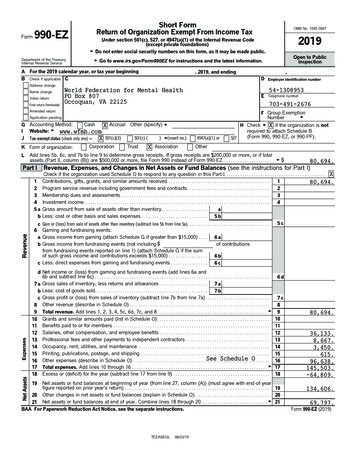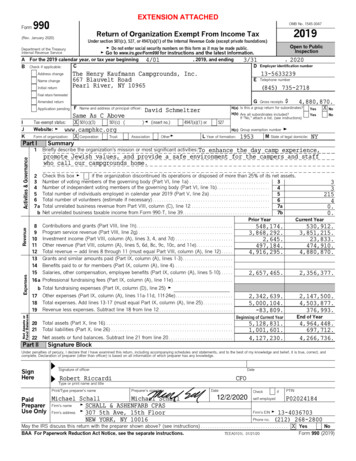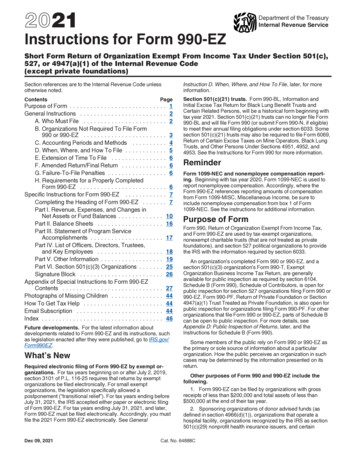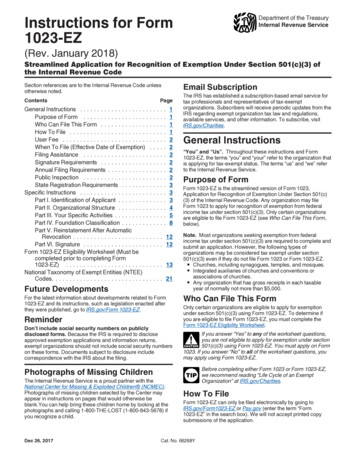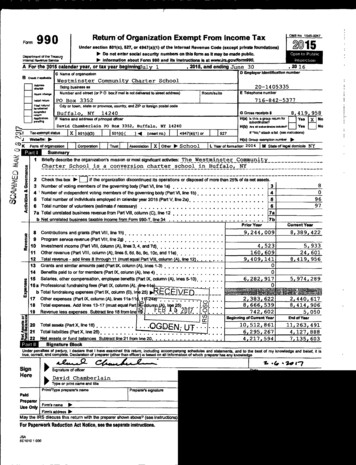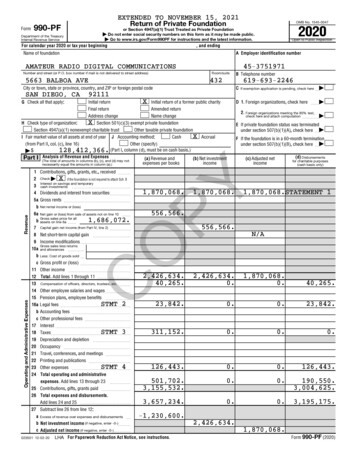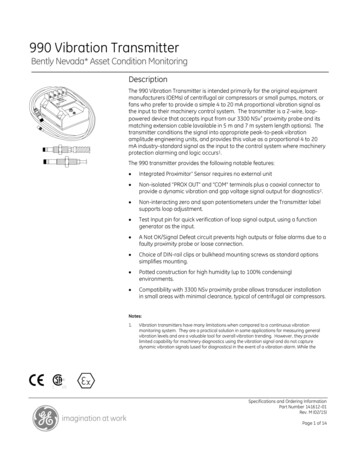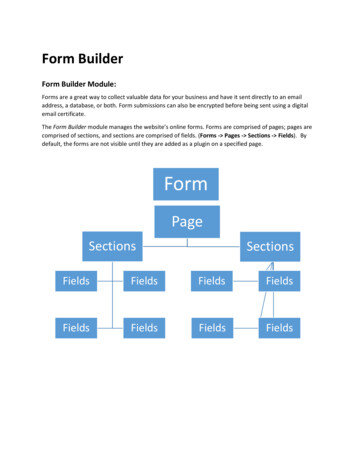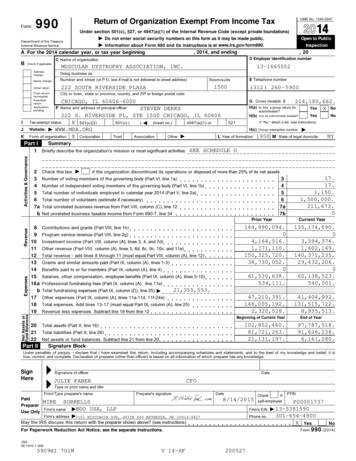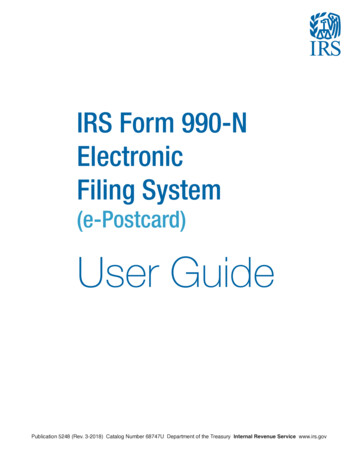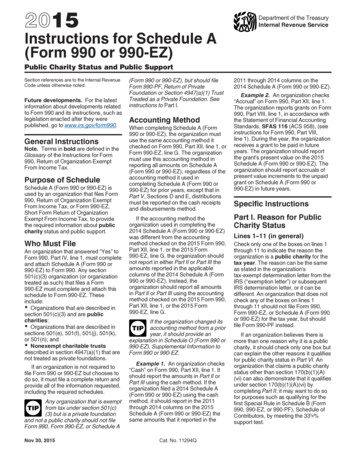
Transcription
2015Instructions for Schedule A(Form 990 or 990-EZ)Department of the TreasuryInternal Revenue ServicePublic Charity Status and Public SupportSection references are to the Internal RevenueCode unless otherwise noted.Future developments. For the latestinformation about developments relatedto Form 990 and its instructions, such aslegislation enacted after they werepublished, go to www.irs.gov/form990.General InstructionsNote. Terms in bold are defined in theGlossary of the Instructions for Form990, Return of Organization ExemptFrom Income Tax.Purpose of ScheduleSchedule A (Form 990 or 990-EZ) isused by an organization that files Form990, Return of Organization ExemptFrom Income Tax, or Form 990-EZ,Short Form Return of OrganizationExempt From Income Tax, to providethe required information about publiccharity status and public support.Who Must FileAn organization that answered “Yes” toForm 990, Part IV, line 1, must completeand attach Schedule A (Form 990 or990-EZ) to Form 990. Any section501(c)(3) organization (or organizationtreated as such) that files a Form990-EZ must complete and attach thisschedule to Form 990-EZ. Theseinclude:Organizations that are described insection 501(c)(3) and are publiccharities;Organizations that are described insections 501(e), 501(f), 501(j), 501(k),or 501(n); andNonexempt charitable trustsdescribed in section 4947(a)(1) that arenot treated as private foundations.If an organization is not required tofile Form 990 or 990-EZ but chooses todo so, it must file a complete return andprovide all of the information requested,including the required schedules.Any organization that is exemptfrom tax under section 501(c)(3) but is a private foundationand not a public charity should not fileForm 990, Form 990-EZ, or Schedule ATIPNov 30, 2015(Form 990 or 990-EZ), but should fileForm 990-PF, Return of PrivateFoundation or Section 4947(a)(1) TrustTreated as a Private Foundation. Seeinstructions to Part I.Accounting MethodWhen completing Schedule A (Form990 or 990-EZ), the organization mustuse the same accounting method itchecked on Form 990, Part XII, line 1, orForm 990-EZ, line G. The organizationmust use this accounting method inreporting all amounts on Schedule A(Form 990 or 990-EZ), regardless of theaccounting method it used incompleting Schedule A (Form 990 or990-EZ) for prior years, except that inPart V, Sections D and E, distributionsmust be reported on the cash receiptsand disbursements method.If the accounting method theorganization used in completing the2014 Schedule A (Form 990 or 990-EZ)was different from the accountingmethod checked on the 2015 Form 990,Part XII, line 1, or the 2015 Form990-EZ, line G, the organization shouldnot report in either Part II or Part III theamounts reported in the applicablecolumns of the 2014 Schedule A (Form990 or 990-EZ). Instead, theorganization should report all amountsin Part II or Part III using the accountingmethod checked on the 2015 Form 990,Part XII, line 1, or the 2015 Form990-EZ, line G.If the organization changed itsaccounting method from a prioryear, it should provide anexplanation in Schedule O (Form 990 or990-EZ), Supplemental Information toForm 990 or 990-EZ.TIPExample 1. An organization checks“Cash” on Form 990, Part XII, line 1. Itshould report the amounts in Part II orPart III using the cash method. If theorganization filed a 2014 Schedule A(Form 990 or 990-EZ) using the cashmethod, it should report in the 2011through 2014 columns on the 2015Schedule A (Form 990 or 990-EZ) thesame amounts that it reported in theCat. No. 11294Q2011 through 2014 columns on the2014 Schedule A (Form 990 or 990-EZ).Example 2. An organization checks“Accrual” on Form 990, Part XII, line 1.The organization reports grants on Form990, Part VIII, line 1, in accordance withthe Statement of Financial AccountingStandards, SFAS 116 (ACS 958), (seeinstructions for Form 990, Part VIII,line 1). During the year, the organizationreceives a grant to be paid in futureyears. The organization should reportthe grant's present value on the 2015Schedule A (Form 990 or 990-EZ). Theorganization should report accruals ofpresent value increments to the unpaidgrant on Schedule A (Form 990 or990-EZ) in future years.Specific InstructionsPart I. Reason for PublicCharity StatusLines 1–11 (in general)Check only one of the boxes on lines 1through 11 to indicate the reason theorganization is a public charity for thetax year. The reason can be the sameas stated in the organization'stax-exempt determination letter from theIRS (“exemption letter”) or subsequentIRS determination letter, or it can bedifferent. An organization that does notcheck any of the boxes on lines 1through 11 should not file Form 990,Form 990-EZ, or Schedule A (Form 990or 990-EZ) for the tax year, but shouldfile Form 990-PF instead.If an organization believes there ismore than one reason why it is a publiccharity, it should check only one box butcan explain the other reasons it qualifiesfor public charity status in Part VI. Anorganization that claims a public charitystatus other than section 170(b)(1)(A)(vi) can also demonstrate that it qualifiesunder section 170(b)(1)(A)(vi) bycompleting Part II; it may want to do sofor purposes such as qualifying for thefirst Special Rule in Schedule B (Form990, 990-EZ, or 990-PF), Schedule ofContributors, by meeting the 331 3%support test.
The IRS does not update its recordson an organization's public charitystatus based on a change theorganization makes on Schedule A(Form 990 or 990-EZ). Thus, anorganization that checks a public charitystatus different from the reason stated inits exemption letter or subsequentdetermination letter, although notrequired, may submit a request to theIRS Exempt OrganizationsDeterminations Office for adetermination letter confirming that itqualifies for the new public charitystatus if the organization wants the IRSrecords to reflect that new public charitystatus (also referred to as “privatefoundation status”). See Form 8940,Request for MiscellaneousDetermination, for instructions. A 400user fee must be submitted with such arequest. See Section 6.09 of Rev. Proc.2015-8, 2015-1 I.R.B. 235.A subordinate organization of agroup exemption that is filing its ownreturn, but has not received its own taxexemption determination letter from theIRS, should check the public charitystatus box which most accuratelydescribes its public charity status.An organization that does not knowthe public charity status stated in itsexemption letter or subsequentdetermination letter should call theExempt Organizations CustomerAccount Services toll free at1-877-829-5500 or write to:Internal Revenue ServiceTE/GE Customer Account ServicesP.O. Box 2508Cincinnati, OH 45201See the following examples:Example 1. The organizationreceived an exemption letter that it is apublic charity under section 170(b)(1)(A)(vi). For the tax year, it meets therequirements for public charity statusunder section170(b)(1)(A)(vi). The organizationshould check the box on line 7 andcompletePart II.Example 2. The organizationreceived an exemption letter that it is apublic charity under section 170(b)(1)(A)(vi). For the tax year, it does not meetthe requirements for public charitystatus under section 170(b)(1)(A)(vi).Instead, it meets the requirements forpublic charity status under section509(a)(2). The organization shouldcheck the box on line 9 and completePart III.Example 3. The organizationreceived an exemption letter that it is apublic charity under section 509(a)(2).For the tax year, it does not meet therequirements for public charity statusunder section 509(a)(2) or170(b)(1)(A)(vi). Instead, it meets therequirements for public charity status asa supporting organization undersection 509(a)(3). The organizationshould:1. Check the box for line 11 andeither line 11a, 11b, 11c, or 11d;2. Complete lines 11e and 11f;3. Complete the table on line 11g;and4. Complete Part IV and (ifapplicable) Part V.Example 4. The organizationreceived an exemption letter that it is asupporting organization undersection 509(a)(3). Based on Rev. Proc.2015-10, 2015-2 I.R.B. 262, theorganization submitted a Form 8940request to the IRS to change itsclassification to public charity statusunder section 509(a)(2). For the taxyear, it meets the requirements ofsection509(a)(2). The organization received adetermination letter that it has beenreclassified as a public charity undersection 509(a)(2). The organizationshould check the box on line 9 andcomplete Part III.Example 5. The organizationreceived an exemption letter that it is apublic charity under section 170(b)(1)(A)(vi). For the tax year, it does not meetthe requirements for public charitystatus under section 170(b)(1)(A)(vi) or509(a)(2), or as a supportingorganization under section 509(a)(3).Nor does it meet the requirements forpublic charity status under any otherprovision of the Internal Revenue Code.The organization is a privatefoundation and should not file Form990, Form 990-EZ, or Schedule A (Form990 or 990-EZ) for the tax year butshould file Form 990-PF instead.Example 6. The organizationreceived an exemption letter that it is asupporting organization under section509(a)(3). The letter does not statewhich type of supporting organization itis. The organization should review theinstructions for lines 11a–11d todetermine which type best describesthe organization. The organization maywish to file Form 8940 to request adetermination of type.-2-Line 1. Check the box for a church,convention of churches, or associationof churches. Pub. 1828, Tax Guide forChurches and Religious Organizations,lists certain characteristics generallyattributed to churches. These attributesof a church have been developed by theIRS and by court decisions. Theyinclude: distinct legal existence,recognized creed and form of worship,definite and distinct ecclesiasticalgovernment, formal code of doctrineand discipline, distinct religious history,membership not associated with anyother church or denomination,organization of ordained ministers,ordained ministers selected aftercompleting prescribed courses of study,literature of its own, established placesof worship, regular congregations,regular religious services, Sundayschools for the religious instruction ofthe young, and schools for thepreparation of its ministers. The IRSgenerally uses a combination of thesecharacteristics, together with other factsand circumstances, to determinewhether an organization is considered achurch for federal tax purposes.Line 2. Check the box for a schoolwhose primary function is thepresentation of formal instruction, whichregularly has a faculty, a curriculum, anenrolled body of students, and a placewhere educational activities areregularly conducted. A private schoolmust have a racially nondiscriminatorypolicy toward its students. For detailsabout these requirements, seeSchedule E (Form 990 or 990-EZ),Schools, and its related instructions.An organization that checks thebox on line 2 must alsocomplete Schedule E (Form990 or 990-EZ), Schools.TIPLine 3. Check the box for anorganization whose main purpose is toprovide hospital or medical care. Arehabilitation institution or an outpatientclinic can qualify as a hospital if itsprincipal purposes or functions are theproviding of hospital or medical care,but the term does not include medicalschools, medical researchorganizations, convalescent homes,homes for children or the aged, orvocational training institutions forhandicapped individuals.Check the box on line 3 also for acooperative hospital serviceorganization described in section501(e).Instructions for Schedule A (Form 990 or 990-EZ)
The definition of hospital forSchedule A (Form 990 or990-EZ), Part I, is different fromthe definition for Schedule H (Form990), Hospitals. Accordingly, see WhoMust File in the Instructions forSchedule H (Form 990) about whetherthe organization also is required tocomplete Schedule H (Form 990).TIPLine 4. Check the box for anorganization whose principal purpose orfunction is to engage in medicalresearch, and that is directly engagedin the continuous active conduct ofmedical research in conjunction with ahospital. The hospital must bedescribed in section 501(c)(3) oroperated by the federal government, astate or its political subdivision, a U.S.possession or its political subdivision, orthe District of Columbia.If the organization primarily givesfunds to other organizations (or grantsand scholarships to individuals) for themto do the research, the organization isnot a medical research organization.The organization is not required to bean affiliate of the hospital, but theremust be a joint effort by the organizationand the hospital to maintain continuingclose cooperation in the active conductof medical research.The definition of medicalresearch for Schedule A (Form990 or 990-EZ), Part I, isdifferent from the definition forSchedule H (Form 990), Hospitals.Accordingly, research that is medicalresearch for purposes of determiningwhether an organization is a medicalresearch organization is not necessarilymedical research for Schedule H (Form990) reporting purposes.TIPAssets test/expenditure test. Anorganization qualifies as a medicalresearch organization if its principalpurpose is medical research, and if itdevotes more than half its assets, orspends at least 3.5% of the fair marketvalue of its endowment, directly inconducting medical research. Eithertest can be met based on a computationperiod consisting of the immediatelypreceding tax year or the immediatelypreceding four tax years.If an organization does not satisfyeither the assets test or the expendituretest, it can still qualify as a medicalresearch organization based on thecircumstances involved.These tests are discussed inRegulations sections 1.170A-9(d)(2)(v)and (vi). Under these tests, value theorganization's assets as of any day in itstax year using the same day every year,and value the endowment at fair marketvalue, using commonly acceptedvaluation methods. See Regulationssection 20.2031.Line 5. Check the box and completePart II if the organization receives andmanages property for and expendsfunds to benefit a college or universitythat is owned or operated by one ormore states or political subdivisions.The school must be an organizationdescribed in the instructions for line 2.Expending funds to benefit a collegeor university includes acquiring andmaintaining the campus, its buildingsand equipment, granting scholarshipsand student loans, and making anyother payments in connection with thenormal functions of colleges anduniversities.The organization must meet thesame public support test described laterfor line 7. See Rev. Rul. 82-132, 1982-2C.B. 107.Line 6. Only a federal, state, or localgovernment or governmental unit thathas received an exemption letterrecognizing it as exempt from tax undersection 501(c)(3) should check this box.See Rev. Rul. 60-384, 1960-2 C.B. 172.Line 7. Check the box and completePart II if the organization meets one ofthe section 170(b)(1)(A)(vi) publicsupport tests. See instructions for Part IIregarding how an organization canqualify as a publicly supportedorganization under section 170(b)(1)(A)(vi).Line 8. Check the box and completePart II if the organization is a communitytrust and meets a section 170(b)(1)(A)(vi) public support test. A communitytrust is a charity that attracts largecontributions for the benefit of aparticular community or area, ofteninitially from a small number of donors,and is generally governed byrepresentatives of its particularcommunity or area. See Regulationssections 1.170A-9(f)(10), (11), and (12).A community trust claiming itqualifies as a public charityCAUTIONshould check the box on line 8whether it is structured as a corporationor as a trust.!Line 9. Check the box and completePart III if the organization meets both ofthe section 509(a)(2) support tests. Seethe instructions for Part III regarding howan organization can qualify as a publiclyInstructions for Schedule A (Form 990 or 990-EZ)-3-supported organization under section509(a)(2).Line 10. Check the box only if theorganization has received a ruling fromthe IRS that it is organized and operatedprimarily to test for public safety.Lines 11 and 11a–11d. If theorganization is a supportingorganization, check the box for line 11and then check the appropriate box forline 11a, 11b, 11c, or 11d to indicate thetype of supporting organization it is. Theorganization must also complete lines11e and 11f, the table on line 11g, andPart IV. If the organization is a Type IIInon-functionally integrated supportingorganization, it must also completePart V.For more information aboutsupporting organizations, seeRegulations section 1.509(a)-4 andsections 509(a)(3) and 509(f). For abrief overview of the requirements forqualification as a supportingorganization, and the different types ofsupporting organizations, see Pub. 557,Tax Exempt Status for YourOrganization, and visit www.irs.gov/Charities- tions.Use the information later todetermine the supporting organization'stype. If the organization checks the boxon line 11e, the letter the organizationreceived from the IRS identifies its type.If the box checked on any of lines 11athrough 11d is different from the typestated in the letter (for example,because the organization has madesignificant changes to its structure oroperations resulting in it no longerqualifying as the type of supportingorganization indicated in its letter),provide an explanation in Part VI. If theorganization does not check the box online 11e, it should check the box online 11a, 11b, 11c, or 11d that bestdescribes the type of supportingorganization it is.All supporting organizations,regardless of type, must beCAUTIONresponsive to the needs ordemands of one or more supportedorganizations, and must constitute anintegral part of, or maintain a significantinvolvement in, the operations of one ormore supported organizations. AlthoughType III supporting organizations havespecific “responsiveness” and “integralpart” tests that must be met, therelationship between a Type I or Type IIsupporting organization and itssupported organization(s) must also!
include these responsiveness andintegral part characteristics. The abilityof the supported organization(s) in aType I or Type II relationship effectivelyto control the supporting organization'sboard generally ensures that thesecharacteristics are present. If they arenot present, however, do not check anybox for lines 11a through 11d. For moreinformation, see Regulations sections1.509(a)-4(f)(3) and (4).Type I. A Type I supportingorganization is operated, supervised,or controlled by one or more publiclysupported organizations. If theorganization otherwise qualifies as asupporting organization and can answer“Yes” to the following question, checkthe box for Type I:Do the supported organizations havea substantial degree of direction overthe policies, programs, and activities ofthe supporting organization, typically byensuring that the governing body,officers, or membership of thesupported organizations may regularlyappoint or elect a majority of thesupporting organization's directors ortrustees?Type II. A Type II supportingorganization is supervised orcontrolled in connection with one ormore publicly supported organizations.If the organization otherwise qualifies asa supporting organization and cananswer “Yes” to the following question,check the box for Type II:Do the same persons, such asdirectors, trustees, and officers,supervise or control the supportedorganization(s) and the supportingorganization?Type III—Functionally integrated.Check this box if the organizationqualifies as a Type III functionallyintegrated supporting organization bymeeting the following requirements:1. The organization meets thenotification requirement described inPart IV, Section D, line 1;2. The organization meets theresponsiveness test (both therelationship requirement and thesignificant voice requirement) describedin Part IV, Section D, lines 2 and 3; and3. The organization meets one ofthe alternative integral part testsdescribed in Part IV, Section E.Type III—Non-functionallyintegrated. Check this box if theorganization qualifies as a Type IIInon-functionally integrated supportingorganization by meeting the followingrequirements:1. The organization meets thenotification requirement described inPart IV, Section D, line 1;2. The organization meets theresponsiveness test (both relationshiprequirement and significant voicerequirement) described in Part IV,Section D, lines 2 and 3; and3. The organization meets theintegral part test by meeting either (a)the distribution and attentivenessrequirements described in Part V or (b)the alternative integral part test forcertain trusts in existence on November20, 1970, described in Part V, line 1.Line 11e. The organization'sexemption letter or subsequentdetermination letter may state the typeof supporting organization it is. If itdoes, check the box on this line. If theletter does not state the type, or if theletter states Type III but does not specifywhether functionally integrated ornon-functionally integrated, leave thisline blank.A grantor to a section 509(a)(3)supporting organization, acting in goodfaith, can rely on this letter indetermining whether the organization isa Type I, Type II, Type III functionallyintegrated, or Type III non-functionallyintegrated supporting organization. SeeRev. Proc. 2011-33, 2011-25 I.R.B. 887and Notice 2014-4, 2014-2 I.R.B. 274.Line 11f. A supporting organizationmust be organized and operatedexclusively to support or benefit one ormore specified publicly supportedorganizations. Please write in the spaceprovided the number of supportedorganizations. Include all supportedorganizations that the organization wasorganized to support at any time duringthe tax year, whether or not they actuallyreceived support during the tax year.Line 11g. An organization checking abox on line 11a, 11b, 11c, or 11d mustcomplete the table on line 11g.Columns (i) and (ii). Enter the nameand employer identification number(EIN) for each supported organizationcounted on line 11f. If the organizationhad more than five supportedorganizations during the tax year, enterthe additional organizations onduplicate pages of Schedule A, Part I.Use as many duplicate copies asneeded, and number each page.Column (iii). For each supportedorganization named in column (i), showwhich line number (from lines 1 through-4-9) best describes the supportedorganization. For example, if theorganization supported a hospital, enter"3" in column (iii). If the organizationsupported a federal, state, or localgovernmental unit, or foreigngovernment, enter "6" in column (iii).Column (iv). Check “Yes” if thesupported organization named incolumn (i) is specifically named as asupported organization in theorganization's declaration of trust,articles of incorporation, or othergoverning document.Column (v). Enter the total amount ofmonetary support paid to, or for thebenefit of, the supported organizationnamed in column (i) during the tax year.Such monetary support may includemaking payments to or for the use ofindividual members of the charitableclass benefited by the supportedorganization (such as scholarships),and to 501(c)(3) public charitiesoperated, supervised, or controlleddirectly by or in connection with thesupported organization. SeeRegulations section 1.509(a)-4(e). If nomonetary support was provided duringthe tax year, enter “-0-.”Column (vi). In this column, theorganization may (but is not required to)provide an estimate of the fair marketvalue of goods, other property, services,and use of facilities that is provided to orfor the benefit of the supportedorganizations during the tax year.Describe in Part VI any such goods,other property, services, and use offacilities, whether or not an amount isreported for them in column (vi).Part II. Support Schedulefor OrganizationsDescribed in Sections170(b)(1)(A)(iv) and170(b)(1)(A)(vi)If the organization checked abox in Part I, on line 5, 7, or 8, itCAUTIONshould complete Part II andinsert the appropriate dollar amounts.Do not leave Part II blank or report onlyzeros if the organization had anysupport during the period. If theorganization checks the box in Part II,on line 13, it should stop there and notcomplete the rest of Part II.!If the organization checked abox in Part I, on line 5, 7, or 8and also checks the box in PartII, on line 18, the organization shouldcomplete Part III to determine if itqualifies as a publicly supportedTIPInstructions for Schedule A (Form 990 or 990-EZ)
organization under section 509(a)(2). Ifit does qualify, the organization shouldinstead check the box in Part I, on line 9.Public Support Test. For anorganization to qualify as a publiclysupported organization under section170(b)(1)(A)(vi), either:331 3% or more of its total supportmust come from governmentalagencies, contributions from the generalpublic, and contributions or grants fromother public charities; or10% or more of its total support mustcome from governmental agencies,contributions from the general public,and contributions or grants from otherpublic charities and the facts andcircumstances indicate it is a publiclysupported organization.Note. An organization will not meeteither of these public support tests ifalmost all of its support comes fromgross receipts from related activitiesand an insignificant amount of itssupport comes from governmentalunits and contributions made directlyor indirectly by the general public.Public support is measured using a5-year computation period that includesthe current and four prior tax years(including short years). If theorganization's current tax year or any ofits four prior tax years were short years,explain in Part VI.If the organization was not a section501(c)(3) organization for the entire5-year period in Part II, report amountsonly for the years the organization was asection 501(c)(3) organization.Line 1. Do not include any “unusualgrants.” See Unusual grants, later.Include membership fees only to theextent to which the fees are payments toprovide support for the organizationrather than to purchase admissions,merchandise, services, or the use offacilities. To the extent that themembership fees are payments topurchase admissions, merchandise,services, or the use of facilities in arelated activity, report the membershipfees on line 12. To the extent that themembership fees are payments topurchase admissions, merchandise,services, or the use of facilities in anunrelated business activity, report themembership fees on line 9. SeeRegulations section 1.170A-9(f)(7)(iv).Include qualified sponsorship paymentsunder section 513(i).Noncash contributions. Use anyreasonable method to determine thevalue of noncash contributions reportedon line 1.Do not report any donations ofservices (such as the value of donatedadvertising space or broadcast air time)or donations of use of materials,equipment, or facilities, on line 1 asgifts, grants, or contributions. Donatedservices and facilities from agovernmental unit only are reportedon line 3.Loss on uncollectible pledge. Ifan organization records a loss on anuncollectible pledge that it reported on aprior year's Schedule A, it should deductthat loss from the contribution amountfor the year in which it originally countedthat contribution as revenue. Forexample, if in the prior tax year theorganization reported a pledgedcontribution with a then-present value of 50,000 in Part II, line 1, column (e), butlearned during the current tax year thatit would not receive any of that pledgedcontribution, it should deduct the 50,000 from the amount reported inPart II, line 1, column (d), for the priortax year.Support from a governmentalunit. Include on line 1 support receivedfrom a governmental unit. Thisincludes contributions, but not grossreceipts from exercising or performingthe organization's tax-exempt purposeor function, which should be reported online 12. An amount received from agovernmental unit is treated as grossreceipts from exercising or performingthe organization's tax-exempt purposeor function if the purpose of the paymentis primarily to serve the direct andimmediate needs of the payorgovernmental unit, and is treated as acontribution, if the purpose is primarilyto provide a direct benefit to the public.For example, a payment to maintainlibrary facilities that are open to thepublic should be treated as acontribution. See Regulations section1.170A-9(f)(8) and Rev. Rul. 81-276,1981-2 C.B. 128. Refer to theinstructions for Form 990, Part VIII, lines1e and 2, for more examples addressingthe distinction between governmentpayments that are contributions andgovernment payments that are grossreceipts from activities related to theorganization's tax-exempt purpose orfunction. Medicare and Medicaidpayments are treated as gross receiptsfrom patients rather than ascontributions from the governmentpayor for purposes of the public supporttest. See Rev. Rul. 83-153, 1983-2 C.B.48.Instructions for Schedule A (Form 990 or 990-EZ)-5-Unusual grants. Unusual grantsgenerally are substantial contributionsand bequests from disinterestedpersons and are:1. Attracted because of theorganization's publicly supportednature,2. Unusual and unexpectedbecause of the amount, and3. Large enough to endanger theorganization's status as normallymeeting either the 331 3% public supporttest or the 10% facts and circumstancestest.For a list of other factors to beconsidered in determining whether agrant is an unusual grant, seeRegulations section 1.509(a)-3(c)(4).An unusual grant is excluded even ifthe organization receives or accrues thefunds over a period of years.Do not report gross investmentincome items as unusual grants.Instead, include all investment incomeon line 8.See Rev. Rul. 76-440, 1976-2 C.B.58; Regulations section 1.170A-9(f)(6)(ii); and Regulations sections1.509(a)-3(c)(3) and (4) for details abo
convention of churches, or association of churches. Pub. 1828, Tax Guide for Churches and Religious Organizations, lists certain characteristics generally attributed to churches. These attributes of a church have been developed by the IRS and by court decisions. They include: distinct legal existence, recognized creed and form of worship,
